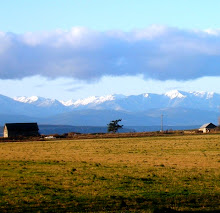
Kelp resembles a plant in many ways--it performs photosynthesis and has parts that look like roots, stems and leaves--but it is in fact a member of the brown algae kingdom because it does not have distinct organs like plants. The part that looks like roots at the bottom of the stipe (stem-like structure), as in these pictures is known as a holdfast and attaches the tall kelp to the rocks. Gas bladders, known as pneumatocysts, form at the base of the blades (leaves), allowing them to float near the surface of the water. Kelp is an annual plant, meaning its life-span is about one year, but can be as long as 18 months. It reproduces by dropping spores.

(Photo by Sierra Young)

(Photo by Sierra Young)
I often look out at Admiralty Inlet from the beach at Fort Ebey and at first think I see the tops of the heads of several harbor seals, but then realize they are only moving with the water. I am actually watching bull kelp, which, while not nearly as cute as harbor seals, is nonetheless interesting and delightfully slimey to the touch.
Post by Sierra Young



No comments:
Post a Comment